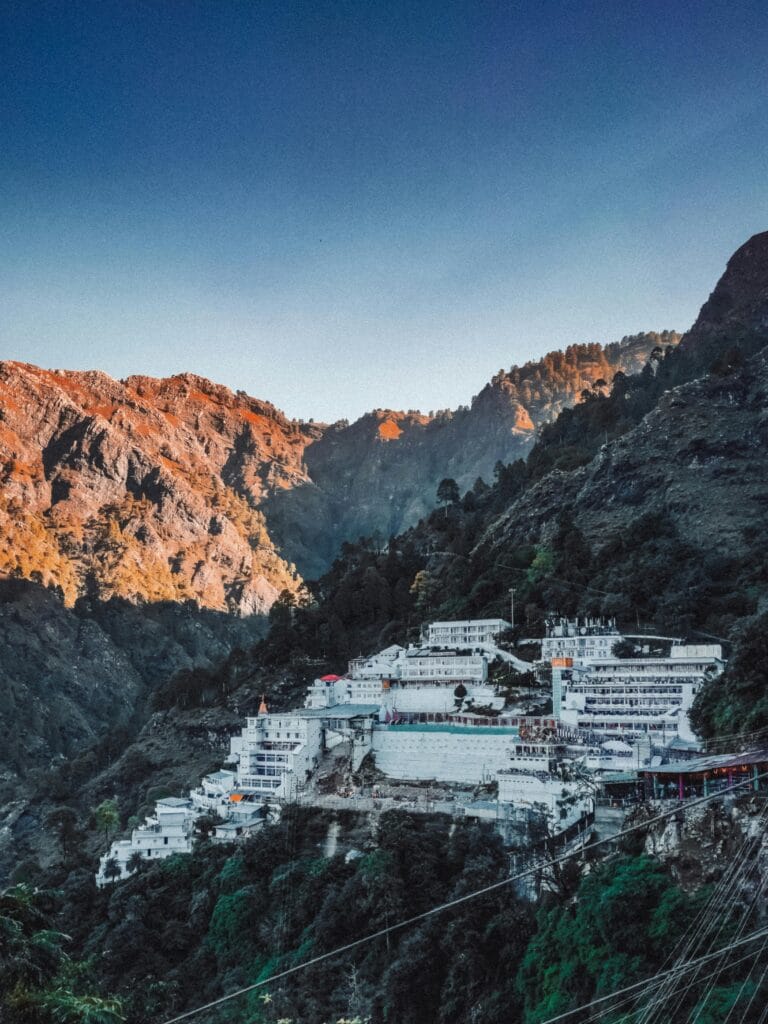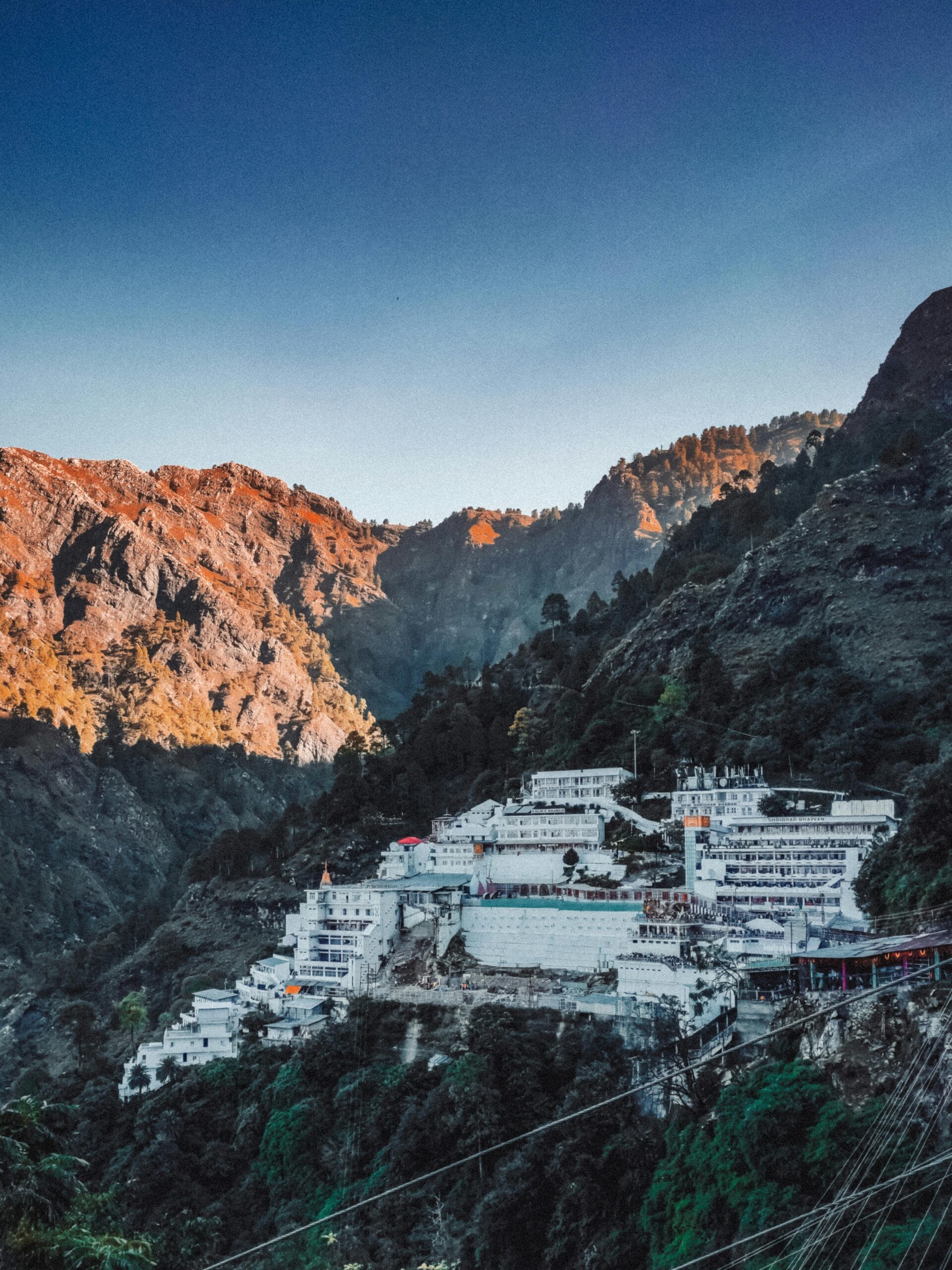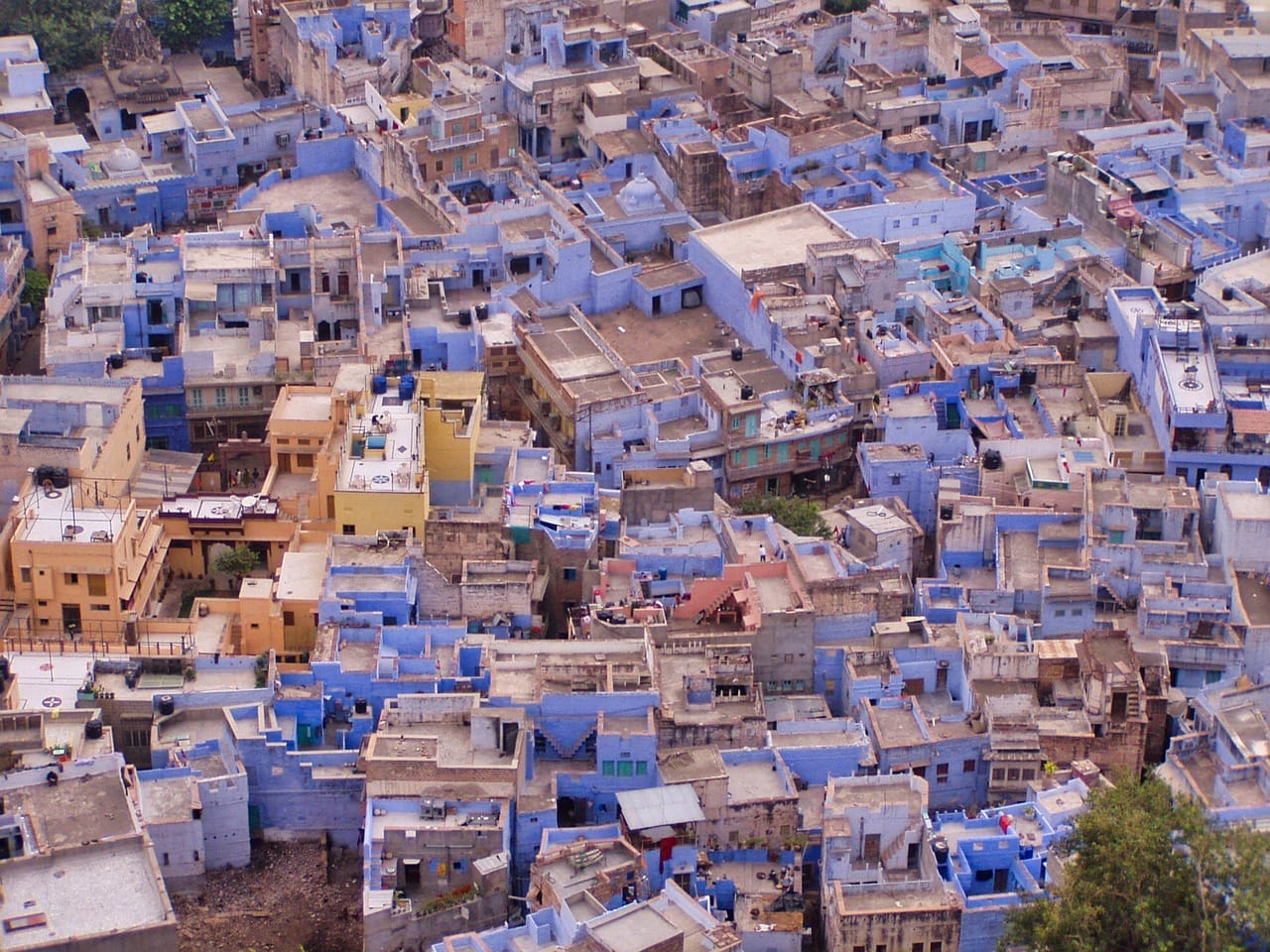Explore the beauty of Kashmir’s sacred shrines such as Shankaracharya Temple and Hazratbal Mosque. It is a guide for those who want to find peace and spirituality in the valley.

Sacred Shrines of Kashmir: A Pilgrim’s Guide
The picturesque valley of Kashmir, often referred to as “Paradise on Earth,” is not only known for its breathtaking natural beauty but also its rich cultural and spiritual heritage. With a blend of Hindu, Islamic, and Buddhist influences, Kashmir is home to sacred shrines that attract pilgrims from across the globe. This guide unveils the most revered spiritual sites, offering insights into their history, architecture, and significance. Let’s embark on a soul-stirring journey through the sacred shrines of Kashmir.
1. Shankaracharya Temple: The Ancient Jewel on the Hilltop
History and Significance
Perched atop the Shankaracharya Hill, the Shankaracharya Temple is dedicated to Lord Shiva. Believed to date back to 200 BC, the temple holds immense spiritual and historical significance. It is named after Adi Shankaracharya, a revered Indian philosopher who visited this temple in the 8th century and meditated here.
Architectural Beauty
The temple is an architectural marvel, constructed with sandstone and featuring intricate carvings. It is accessible via a series of steps, leading pilgrims through lush greenery to the summit, where the panoramic views of the Dal Lake and Srinagar city are nothing short of divine.
Best Time to Visit
Plan your visit during the spring or autumn months to enjoy pleasant weather and clear views of the surroundings.
2. Hazratbal Shrine: A Testament to Faith
Historical Background
Located on the northern shores of Dal Lake, the Hazratbal Shrine is the most sacred Islamic site in Kashmir. It houses the relic believed to be a hair strand of Prophet Muhammad (PBUH). The shrine’s name, “Hazratbal,” translates to “respected place.”
Architecture and Surroundings
The white marble structure is a blend of Mughal and Kashmiri styles. Surrounded by manicured gardens and the serene Dal Lake, the shrine offers a tranquil environment for prayers and reflection.
Festivals and Celebrations
Thousands of devotees gather during Eid and other Islamic occasions to witness the public display of the holy relic.
3. Amarnath Cave Temple: A Journey of Devotion
The Mythological Connection
Nestled in the snow-capped Himalayas, the Amarnath Cave Temple is one of the most sacred Hindu shrines. Dedicated to Lord Shiva, the cave is renowned for its naturally formed ice lingam, which symbolizes the deity.
The Challenging Pilgrimage
The Amarnath Yatra, an annual pilgrimage, is a test of faith and endurance. Pilgrims undertake a trek through rugged terrain, braving extreme weather to seek blessings.
Best Time to Visit
The cave is accessible during the summer months of July and August, when the ice lingam forms naturally.
4. Kheer Bhawani Temple: A Sacred Abode of Goddess Ragnya
Mythology and Beliefs
Dedicated to Goddess Ragnya Devi, the Kheer Bhawani Temple is located in the Tullamulla village. The name “Kheer Bhawani” derives from the offering of rice pudding (kheer) to the goddess. It is believed that the color of the temple’s spring water foretells future events.
Architectural Highlights
Surrounded by Chinar trees and serene landscapes, the temple features a sacred spring at its center. Pilgrims flock here during the annual festival of Jyestha Ashtami.
5. Jamia Masjid: The Grandeur of Kashmiri Islamic Architecture
Historical Overview
Situated in the heart of Srinagar, the Jamia Masjid is an architectural masterpiece built in 1402 by Sultan Sikandar. Its Indo-Saracenic design and serene ambiance make it a must-visit.
Unique Features
The mosque’s 378 wooden pillars and spacious courtyard are awe-inspiring. Its tranquil environment contrasts with the bustling markets surrounding it.
6. Vaishno Devi Temple: A Pilgrimage of Devotion and Faith
Sacred Significance
Though technically located in the Trikuta Hills of Jammu, Vaishno Devi is an essential stop for pilgrims visiting the region. Dedicated to Mata Vaishno Devi, a manifestation of the Hindu Goddess Durga, this shrine is one of the most revered Hindu temples in India.
The Pilgrim’s Journey
Pilgrims undertake a 12 km trek to the holy cave, starting from Katra. The journey is marked with chants of “Jai Mata Di,” and facilities such as pony rides, helicopter services, and refreshments are available along the way.
Divine Atmosphere
The cave enshrines three pindis (natural rock formations), symbolizing the goddesses Mahakali, Mahalakshmi, and Mahasaraswati. Devotees believe that a visit fulfills their wishes and cleanses the soul.
7. Martand Sun Temple: A Glimpse into Kashmir’s Glorious Past
Historical Marvel
The Martand Sun Temple, located near Anantnag, is a striking example of ancient Kashmiri architecture. Built by King Lalitaditya in the 8th century, this temple was dedicated to the Sun God.
Architectural Grandeur
Although in ruins, the temple’s layout, with its large courtyard and awe-inspiring colonnades, speaks volumes about its former magnificence. Surrounded by mountains, the site is a photographer’s paradise.
Cultural Significance
The Martand Sun Temple is a UNESCO World Heritage Site nominee, symbolizing Kashmir’s architectural and cultural heritage.
8. Charar-e-Sharief: The Shrine of Sheikh Noor-ud-Din Wali
About the Saint
Sheikh Noor-ud-Din Wali, also known as Nund Rishi, is a revered Sufi saint in Kashmir. Charar-e-Sharief, located about 30 km from Srinagar, is dedicated to his teachings and legacy.
Architectural and Spiritual Aura
The wooden structure of the shrine, rebuilt after a fire, exudes a sense of serenity and spiritual connection. Pilgrims and Sufi followers flock here to seek blessings and meditate.
9. Pari Mahal: A Blend of Spirituality and Mughal Elegance
Historical Insights
Pari Mahal, or “Palace of Fairies,” is a historic site located near Srinagar. Originally built as a library and retreat for Dara Shikoh, the Mughal prince, it later gained spiritual significance.
Architectural Splendor
This terraced garden, with its sweeping views of Dal Lake, combines Mughal aesthetics with Islamic design principles. Pari Mahal is as much a spiritual retreat as it is a historical landmark.
10. Ziarat Sharief of Baba Reshi: A Sufi Pilgrimage Spot
Legacy of Baba Reshi
Located near Gulmarg, the Ziarat Sharief is a shrine dedicated to Baba Payamuddin, a Sufi saint who lived in the 15th century.
Tranquility Amid Nature
The shrine, surrounded by dense forests and rolling meadows, offers a peaceful environment for meditation and prayer. Its wooden architecture is a testament to traditional Kashmiri craftsmanship.
11. Khanqah-e-Moula: A Beacon of Kashmiri Spirituality
Historical Legacy
Located on the banks of the Jhelum River in Srinagar, Khanqah-e-Moula is one of the oldest Muslim shrines in Kashmir. It was built in memory of Mir Syed Ali Hamdani, a revered Persian saint who played a significant role in spreading Islam in the region.
Architectural Marvel
The shrine is a masterpiece of Kashmiri woodwork, featuring intricately carved panels and papier-mâché decorations. The interior exudes an aura of tranquility, with its soft lighting and sacred ambiance drawing devotees from near and far.
Special Occasions
On Urs (death anniversary of the saint), the shrine is adorned with lights, and special prayers are offered, making it a vibrant hub of spiritual activity.
12. Chatti Padshahi Gurudwara: A Sikh Heritage Site
Sikh Connection
The Chatti Padshahi Gurudwara in Srinagar is one of the most important Sikh pilgrimage sites in Kashmir. It is associated with the sixth Sikh Guru, Guru Hargobind Sahib, who is believed to have visited this place during his travels.
Peaceful Retreat
The gurudwara offers a serene environment for worship and reflection. Devotees gather here to listen to kirtans (devotional hymns) and partake in the langar (community meal), a symbol of equality and service in Sikhism.
Welcoming Atmosphere
Open to people of all faiths, the Chatti Padshahi Gurudwara exemplifies the spirit of universal brotherhood.
13. Aishmuqam Shrine: The Abode of Hazrat Zain-ud-Din Wali
Spiritual Significance
Situated in the Anantnag district, the Aishmuqam Shrine is dedicated to Hazrat Zain-ud-Din Wali, a renowned Sufi saint and disciple of Sheikh Noor-ud-Din Wali. The shrine is built into a hillside cave, adding to its mystical charm.
Festivities and Faith
The annual Urs festival attracts a large number of devotees, who light candles and chant prayers to honor the saint.
A Unique Experience
The spiritual ambiance combined with the breathtaking views of the valley makes this shrine a must-visit for pilgrims and travelers alike.
14. Takht-e-Sulaiman: A Sacred Hilltop Shrine
Historical Significance
Also known as Throne of Solomon, Takht-e-Sulaiman is an ancient site believed to be associated with the biblical King Solomon. The site features a small temple that predates the Shankaracharya Temple and holds immense historical importance.
A Trek Worth Taking
Reaching the site involves a challenging yet rewarding trek. The panoramic views of the valley and the spiritual vibes at the summit make it a favorite among adventurers and pilgrims.
15. Pandrethan Temple: A Lesser-Known Gem
Historical Insight
Pandrethan Temple, located near Srinagar, is a well-preserved example of ancient Kashmiri architecture. Dedicated to Lord Shiva, it is believed to have been built during the 9th century.
Architectural Splendor
The temple stands in a small pond, giving it an ethereal appearance. Its intricate carvings and stone craftsmanship are a testament to the region’s rich heritage.
Serene Environment
Away from the bustling tourist spots, the Pandrethan Temple offers a peaceful retreat for those seeking solitude and spirituality.
Conclusion
Kashmir’s sacred shrines are more than just places of worship; they are symbols of its rich cultural and spiritual heritage. From the ancient temples dedicated to Hindu deities to the serene Sufi shrines and Islamic mosques, these sites reflect the harmonious coexistence of diverse faiths in the valley. Whether you are a pilgrim seeking divine blessings or a traveler looking for cultural enlightenment, the sacred shrines of Kashmir offer a transformative experience.
FAQs
1. What is the best time to visit the sacred shrines of Kashmir?
The best time to visit is during spring (March to May) and autumn (September to November), when the weather is pleasant, and the valley is at its scenic best.
2. Are the shrines in Kashmir accessible to people of all religions?
Yes, most shrines in Kashmir welcome visitors of all faiths, promoting the spirit of inclusivity and harmony.
3. How can I prepare for the Amarnath Yatra?
Proper physical preparation, advance registration, and following the guidelines provided by the authorities are essential for a safe pilgrimage.
4. Is photography allowed at these shrines?
Photography is allowed at some shrines, but visitors should respect the sanctity of the place and adhere to the specific rules of each site.
5. Are there any accommodation options near these shrines?
Yes, there are numerous hotels, guesthouses, and homestays near the shrines, catering to various budgets and preferences.



